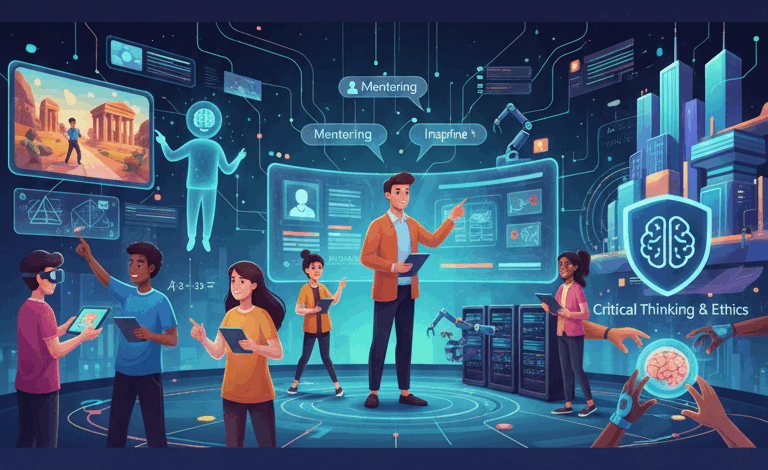AI in Education: Revolutionizing Learning by 2025

Introduction
Imagine a school where every lesson is custom-made for you, where a virtual tutor is always ready to help, and teachers spend more time inspiring than grading papers. Sounds futuristic? Welcome to education in 2025, powered by Artificial Intelligence! AI isn’t just a buzzword; it’s rapidly reshaping how we learn and teach, moving beyond sci-fi to become a practical partner in classrooms and lecture halls worldwide. Expect a dive into AI’s origins in education, its current applications, the debates it stirs, and its impact on students, teachers, and administrators.
A Quick Trip Down Memory Lane: AI’s Journey in Education
Consider the arc of technological integration into education, a journey beginning long before the current AI frenzy. The dawn of digital learning in the 1960s-1980s saw the emergence of basic “Computer-Assisted Instruction” (CAI). PLATO, a system from the ’60s offering personalized math and science lessons, represented a true pioneer for individualized learning, despite its clunky, rule-based nature. The subsequent era (1970s-1990s) witnessed the conceptualization of machines as personal tutors in the form of “Intelligent Tutoring Systems” (ITS). These systems sought to emulate human tutors, adapting to student difficulties and offering hints. Natural Language Processing (NLP) started making its way into language learning.
The early 2000s saw AI creep into everyday school life with Learning Management Systems (LMS) like Blackboard, automating tasks like attendance and resource recommendations, albeit lacking “intelligence” in today’s sense. The 2010s brought a huge leap with adaptive learning platforms (like DreamBox), dynamically changing lessons based on student performance, thus personalizing the learning path. Then came the ChatGPT “Tsunami” (2022-Present). The emergence of generative AI, spearheaded by ChatGPT, changed everything in late 2022. Suddenly, AI could write essays, code, and brainstorm, sparking excitement and panic in equal measure, leading to policy shifts as schools either banned or embraced it, and tech giants integrated it into their platforms.
AI in Action: What’s Happening in Schools and Universities Right Now
The practical implications of AI in today’s educational landscape are substantial. Personalized learning is now on steroids, with AI creating unique learning paths, adapting content, pace, and feedback to each student’s needs and style, effectively eliminating the “one-size-fits-all” lecture model. Intelligent tutoring systems, like Khanmigo, offer instant help, guiding students to find answers and master tough concepts anytime, anywhere, acting as a 24/7 tutor. AI also gives teachers their time back by automating tedious administrative tasks like grading quizzes, generating lesson plans, tracking attendance, and even drafting communications. This frees up educators to focus on what they do best: direct student interaction, mentoring, and fostering social-emotional growth.
Moreover, AI is enabling smarter content and easier access. AI helps teachers create interactive materials, simulations, and diverse content tailored to curriculum standards and different learning needs. AI tools such as text-to-speech and real-time translation are making education more accessible for students with disabilities and multilingual learners. Beyond the grades, adaptive assessments powered by AI provide instant, detailed feedback and analyze performance trends, helping teachers intervene exactly when needed. Assessments are evolving to evaluate critical thinking and problem-solving, even through interactive AI conversations.
The Elephant in the Classroom: Controversies and Concerns
However, the integration of AI in education is not without its controversies and concerns. The issue of cheating, plagiarism, and academic integrity is paramount. The fact that AI can write essays raises questions about how to ensure students are actually learning and not just outsourcing their brains. The “human touch” debate also looms large, with concerns about the loss of genuine human interaction, mentorship, and the development of crucial social skills. Can a chatbot truly replace a compassionate teacher?
Bias in the algorithms presents another challenge. AI systems learn from data, and if that data is biased, the AI can perpetuate or even amplify existing inequalities, potentially leading to unfair outcomes for certain student groups. The question of who owns student data also raises serious privacy and security concerns. AI sucks up tons of student data – performance, behavior, even personal info. Who’s watching? What are they doing with it?
The prospect of job security for educators is another concern. While most experts believe AI will change roles rather than eliminate them, the anxiety about job displacement, especially for administrative staff, is real. The digital divide could also widen, as advanced AI tools can be expensive and require good internet, potentially disadvantaging students and schools in underserved communities, creating an “AI divide.” Finally, there’s the worry about AI “dumbing down” critical thinking. If AI gives you all the answers, do students still learn how to think critically, research independently, and solve problems creatively?
Looking Ahead to Tomorrow: The Future of AI in Education (2025 and Beyond)
Looking forward, AI literacy is poised to become a core skill. Learning about AI (how it works, its ethics, its risks) is becoming as crucial as reading and writing, with schools integrating AI fluency into curricula. Expect AI to move beyond pilot programs into the fabric of school operations – from student services (AI chatbots for college advice) to curriculum development and resource allocation. Immersive learning will take flight, with AI combined with VR/AR to create mind-blowing virtual field trips, realistic simulations, and experiential learning that’s truly engaging.
The evolving role of the educator will see teachers becoming AI “orchestrators” – designing AI-enhanced learning experiences, interpreting data insights, and focusing on human-centric skills like empathy, collaboration, and ethical reasoning. As AI rapidly evolves, expect a flurry of new policies and ethical frameworks to govern its use, ensuring fairness, transparency, and accountability. UNESCO is already leading the charge for a human-centered approach. The focus will remain on ensuring equitable access to AI tools and training for all students, striving to bridge the digital divide rather than widening it.
Conclusion
In conclusion, AI is not just changing education; it’s revolutionizing it. From personalized learning and administrative relief to ethical dilemmas and workforce readiness, its impact is undeniable. Yet, while AI offers incredible tools, the future of education still hinges on the human spirit – critical thinking, creativity, empathy, and the unique connection between teachers and students. How will you adapt to this AI-powered learning landscape? The revolution is here – are you ready to embrace it responsibly?





